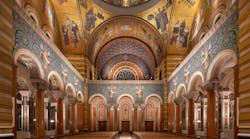The Challenge:
Much has changed at home games for the NFL’s storied Green Bay Packers since the team first kicked off in 1919—they no longer dress at a nearby high school, for instance. Instead, Wisconsin’s proud pro-football franchise plays at Lambeau Field. The stadium’s capacity—approximately 80,000—has more than doubled since the team began occupying the hallowed gridiron back in 1957.
More than likely, most Packers fans—also known as “Cheeseheads”—are hyper-focused on the players and their on-field exploits and not the stadium’s lighting system. But for the people who work at Crestron Electronics, the lights at Lambeau Field are serious business.
Bill Schafer is one such person. Crestron’s executive vice president, Commercial Lighting, was kind enough to take time from his busy schedule and converse with Architectural SSL magazine about how the company helped get the Green Bay Packers ready for some football.
What was the issue at Lambeau when the team called Crestron?
To keep up with the times, Lambeau began a series of renovations, starting in 2001, that left its facilities team to contend with over a dozen separate lighting control systems from different manufacturers that were not fully integrated. On game days, this meant the facilities teams were responsible for navigating nearly 10 miles of combined steps across over 2 million sq. ft. of stadium space just to turn on all the lights, which, of course, needed to be turned off afterward as well. This already tiresome exercise became even more complex as the stadium’s primary control system began to fail.
Yikes. What then?
When the Lambeau facilities team evaluated this primary system for repair, they discovered that the product, which had neared the end of its lifecycle, had been sunsetted by its manufacturer. This meant that repair components were no longer available, and the team needed a wholesale replacement of the system.
Looking first to the other systems they had on-site for inspiration, the facilities team realized many of those were failing as well. The decision to standardize on a single control system flowed logically from there.
What were some of the features and functionalities that were important for the new lighting control system to possess?
The Lambeau team was looking for a new lighting system that covered a few key priorities: future-proofing, security, interoperability, and scalability.
What was delivered?
Crestron delivered a system that satisfied each of these conditions. The system is standards-based, so if the product sunsets or the manufacturer goes under, replacement components will be easy to find and administer.
An open protocol ethernet backbone dramatically increases command execution speed and eases future maintenance relative to past systems that relied on proprietary wired connectivity.
Strict IT security standards that included Active Directory Credential Management integrated authentication on the control device with the stadium’s enterprise-wide IT.
The system is able to integrate all across the stadium, including into AV control room systems, so that after touchdowns or other significant events, the facilities team can sync lighting scenes in the seating bowl with lighting elsewhere in the stadium.
Flexibility for future growth was a final mandate. The overhaul of existing lighting control was only Phase 1 of Lambeau’s plan; the team needed lighting control to scale alongside future renovations, too.
How does the facility and its staff benefit from the system?
The single, unified system has unlocked savings in time, energy consumption, and cost of ownership. Stadiums that standardize on a single system have also recouped considerable energy consumption costs, as lights are now in use only for the exact amount of time they need to be.
How much has Lambeau saved since the installation of the new system?
Though data from Lambeau is not available, a comparable stadium, Detroit’s Little Caesars Arena—home of the Detroit Pistons and Detroit Red Wings—shaved nearly 20% off their annual energy cost when they switched from a disparate matrix of systems to a single solution. A switch to more efficient LED bulbs accounts for a share of these savings, but that’s just further proof the more you look at stadium commercial lighting, the more areas for improvement you will find.
Does the fan experience improve?
According to a Deloitte study on stadium experience, fans have four core experiential concerns: a safe, comfortable, and clean environment, a satisfactory view from their seat, a high-quality game, and an exciting stadium atmosphere.
While gameplay is the responsibility of the teams themselves, the remaining three concerns are far more dependent on the facilities team. Onboarding Lambeau’s commercial lighting onto a single system should help the facilities team improve on each of these three fronts.
How so?
Instead of assigning two unlucky team members the job of traversing the concourse to turn on the stadium’s lighting, facilities managers can simply press a few buttons on a single panel to engage a building-wide lighting scene.
Released from their miles-long lighting control traipse, staff can focus on improving other elements of fans’ four core concerns. A well-lit space always makes spectators feel safer and is easier to keep clean. Although commercial lighting will not have much impact on gameplay, the fans’ process of getting to those seats is improved through better lighting. Dynamic lighting controls in stadium concession areas, bars, and pro shop spaces improve fan experience as well—and can drive additional retail spending.
This article appeared in the September 2022 issue of Architectural SSL magazine.








